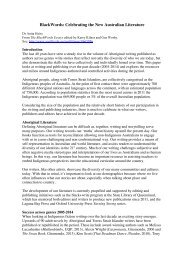7209743364812265548-Aboriginal-Literature-for-Children
7209743364812265548-Aboriginal-Literature-for-Children
7209743364812265548-Aboriginal-Literature-for-Children
You also want an ePaper? Increase the reach of your titles
YUMPU automatically turns print PDFs into web optimized ePapers that Google loves.
whitefella’s house”, the church, water tank, and the road to Alice Springs. The time-linesoffer simple yet significant notes on what happened and when in the region and nationally.Reading about the history of Australia has never been so interesting and enjoyable, althoughschool children often claim learning history is boring. Appropriate resources are the key toteaching history in an engaging way and the template designed by Papunya School couldeasily be adapted by communities nationally, both <strong>Aboriginal</strong> and non-<strong>Aboriginal</strong>, as a meansof recording the history of a particular place and people, making it interesting and relevant tochildren around the country.Following that template is the late Mary Malbunka’s When I was Little, Like You (Allen &Unwin, 2003), which shows the similarities between children growing up, regardless ofgeography and cultural affiliations. Malbunka’s strategy is one of unifying children ofdifferent backgrounds, countering the fear of difference that is often instilled by mainstreammedia. The author uses language (her own Luritja and English) as well as contemporaryillustrations and traditional dot paintings to tell the story of her life as a pipirri (child)growing up in both her mother and father’s ngurra (country)—Warlpiri and Pintupi.The inclusive nature of Malbunka’s title, When I Was Little, Like You, (Allen and Unwin,2003) is obvious when one reads of her childhood. There are some things that all youngpeople do regardless of culture, social status or geography—such as playing games,swimming (whether beach, river or creek), building and playing in cubby houses, ditchingschool, knocking off fruit from the neighbour’s tree and garden and so on. These are things Ialso did as a young child growing up in the eastern suburbs of Sydney. Of course, there werethings that Malbunka did as a child that I didn’t do, although I wished I had—like sittingaround the campfire and learning from the old people about place names and stories relevantto near-by lands. While I didn’t learn that way, Malbunka’s book shows me how she did, andhow she later passed along that same in<strong>for</strong>mation to young people in her country, includingin<strong>for</strong>mation about where some animals are found. For example the tjilkamata (echidna) andkanyala (wallaby) prefer puli (rocky country), while the malu (kangaroo) and kalaya (emu)can be found in tjata (scrub country). We also learn that it’s best to hunt <strong>for</strong> malu in the dryseason because that’s when they are the fattest.The success in putting this book together means that, although it is classified in the genre ofchildren’s and youth’s literature, it will engage readers of all ages page after page. Thelanguage notes and diagrams at the end of the book equip the reader in understanding how toread Malbunka’s illustrations, making the most of this culturally and socially rich book.Like The Papunya School Book, Mary Malbunka’s work is also a history book <strong>for</strong> allAustralians. It was shortlisted <strong>for</strong> the 2003 NSW Premier’s History Award <strong>for</strong> Young Peoplebecause the judges believed it was a book that would nurture intercultural understanding inall the children who read it:This clearly told story would appeal to both <strong>Aboriginal</strong> and non-<strong>Aboriginal</strong> children,with its narratives of Mary's life, growing up in the 1960s. Historical elements includeexperiences at a government settlement, glimpses of traditional living, ‘SorryBusiness’ and difficulties of dealing with the demands of two languages - English andLuritja. Both languages feature in the story telling with an English/Luritja glossaryprovided. An appealing book, it is an interesting recording and passing on ofexperiences closely resembling traditional oral accounts. It plays an important role in




